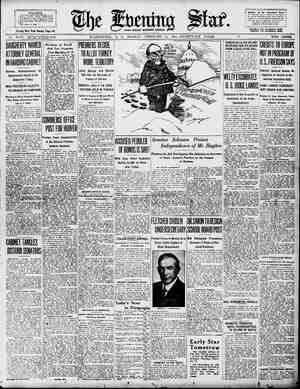The Nonpartisan Leader Newspaper, February 21, 1921, Page 7
You have reached the hourly page view limit. Unlock higher limit to our entire archive!
Subscribers enjoy higher page view limit, downloads, and exclusive features.
lwere willing to come to the list price except the National agent, and the agents at Ambrose are also ° willing to, so we are coming closer to business now, I think.” ~ e : The following letter, written after the prohibition law had become effective, shows how the grain. companies instructed their agents to do business: Z , _ September 1, 1919, Mr. B. G. Cochrane, Detroit, Minn. Dear Bert: We have your letters of the 30th relative to conditions along the line north of Grand Forks, * * * - _ We are quite surprised to see that you can not solve the Drayton situation. “We had expected you to go up there to look this matter over for a few minutes and then put that market on a strictly list _basis, and as stated above, we are quite surprised that you did not see how to bring this about. The only thing we can suggest is to carry a little lemon extract on your hip as this will help the situation out as long as the extract lasts. : el ANDREWS GRAIN CO. HGT*ML o By Dozens of otheyp letters, to the same effect as those cited above, might be quoted. They can be found in the report of the federal trade commission on the grain trade, volume 1, “Country Grain Marketing,” which can be obtained at the Govern- ".ment Printing Office, Washington, D. C., for 35 cents. Before we leave the subject of price-fixing, however, let us notice a few letters on prices of things that the elevators have fo sell, as well as what they buy. ; g First this one about how things were fixed up at the local station: s (From the files of the Atlantic Elevator Co.) Oakes Station, July 28, 1916. Atlantic Elevator Co. Dear Sirs: I have seen the Salzer man and Knox ‘Grain Co. and the following is what we have agreed on as coal prices: Stove size, hard.. ...$11.50 $9.60 Nut size, hard ... ... 1125 9385 H. V. size, hard ..... essie 176 61D Millers Creek, hard ........ 8756 7.00 " This is out bin. I had two talks with the Hawkeye Elev. man but didn’t get any satisfaction. Can’t you take the matter up with the Hawkeye people there and let us know ? Yours trulg, ; R. O. SMITH. SURE, THEY “TOOK UP” THE MATTER AT MINNEAPOLIS Then these two, which indicate how matters were “taken up” at Minneapolis: : November 11, 1918. Northland Elevator Co., City. Gentlemen: * * * We thought best to write BUFFALOES AND HUMAN BEINGS John Baer Gives Us a Lecture on Natural History and Economics at the Same Time BY JOHN M. BAER A A At e ou_about this as the prices that we agreed upon ast’ Wednesday at that station were as follows: Hard coal ..... . ..$11.75 Hocking ....... . .. 9.50 Millers Creek ....evveecsascccosss 10.00 We are not disposed to sell coal at prices our agent has advised us about, and think we should in- struct them to hold the prices that we gave them, and have wtitten our agent to sell at the prices that we arranged with you last. 7 ~ We hope you will see fit to instruct your man in the _same way. Yours truly, WOODWORTH ELEVATOR CO. RPW*E By R. P. Woodworth, Sec. NORTHLAND ELEVATOR CO. Mpls., Minn., July 31, 1915. ‘Atlantic Elevator Co., City. Gentlemen: Our agent at Armourdale, N. D., advises us that your agent at that station is selling barley locally at 7c over list. Our retail price for barley at all stations is 10c over “C” list. Yours truly, NORTHLAND ELEVATOR CO. FIS*OM By F. J. Smith, In the next issue the Leader will go on with the story and will show, by the grain gamblers’ own letters, what happened when the farmers started to build elevators. These letters of the grain men are particularly interesting. Don’t miss them. the buffalo once roamed, there are deep-worn circular paths. The tourist driving over the fenceless prairie often runs across them, sometimes so hidden by the grass that they give a severe test to his shock absorbers. Few but the old-timers know how these rings were formed. They are a last relic of the days of the buffalo. : ; ~Attacked by wolves, the buffaloes would gather the weak and young in the center. The strong and sturdy then galloped around them. The wolves could not break the ring. If they got in the path of the galloping buffaloes they were stamped and crushed to THROUGHOUT the prairie region of the United States, where a prey to the wolves, and his end is indicated by the skull and bones at the left. The buffaloes showed a remarkable instinct for co-operation and organization. Because of this they grew and multiplied until they were the dominant animal of the West. It was only when the white man, with his rifle, organized for tremendous slaughter, that the buffalo met its fate. . ¥ Many human beings do not show as much sense as the buffa- loes. They try to protect themselves individually. They do not organize and co-operate with their fellow beings against the forces that prey on them. death. Only the poor, half-witted buffalo, who tried to work alone, fell AN S ~sv-Hihd’s W= Their fate is likely to be that of the occasional buffalo who thought he was strong enough to defy the wolves alone. Lokl 8 Nl ///ILM‘ : W, (A Ul e








